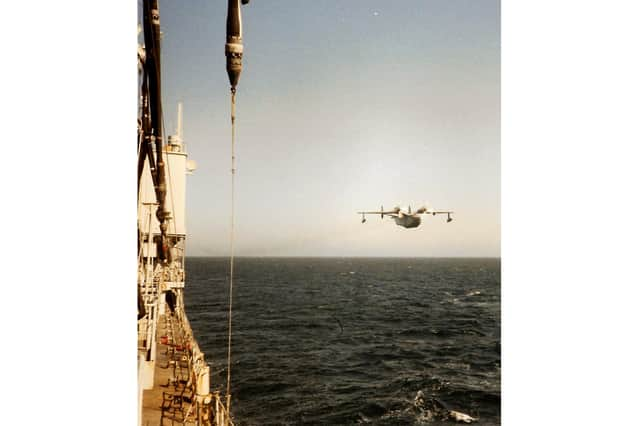Royal Navy supply ship in Cold War clash with Soviets | Nostalgia


Back in the 1980s, Andy August, of Cowplain, was a serving officer in RFA Olna.
She was a 'fast fleet tanker’ of the Royal Fleet Auxiliary. She had served in the Falklands, was decommissioned in 2000 and scrapped the following year.
Advertisement
Hide AdAdvertisement
Hide AdOn one occasion the ship was buzzed by a Russian Beriev BE-12 Chayka. The NATO reporting name was ‘Mail’. A Soviet amphibious aircraft, it had a 98ft wingspan with a top speed of 330mph with a range of more than 2,000 miles.
The aircraft carried torpedoes, depth charges, mines and bombs. You can see why the British ships had to be careful.
Andrew tells me aircraft would swoop down and fly around the ship several times. ‘It could be quite worrying as you can imagine. They appeared to be just nosey and kept an eye on what we were doing which was practically nothing when the aircraft was in sight. They did fly very close to the ship though.’
The Cold War ended in 1991 and British seamen could travel the world safely.
Advertisement
Hide AdAdvertisement
Hide Ad• Some readers might have read my book Portsmouth – City of Gallant Hearts which tells of the civilians who were killed in the blitz during the Second World War.
Since publication I’ve heard from quite a few people who missed my request for family stories the first time around.
It is now 76 years since the end of the war and time marches on. If you have memories of family lost in the bombing and have photographs then please contact me and I will endeavour to interview you.
Photographs will not have to be taken out of your possession as I can photograph the photograph in your home to reproduce it. If you would like to see me then please email me at [email protected].
Advertisement
Hide AdAdvertisement
Hide Ad• There has been much in the letters pages of The News recently about the state of Southsea and how it once was.
The late William Curtis wrote a book many years ago called Southsea – Its Story. In it he tells how wonderful Southsea was and how it attracted so many holidaymakers and day visitors.
In the mid-1920s it was decided that Southsea must become a popular seaside resort. The common was a big asset but its use was governed by the War Department.. The Corporation managed to buy the land for £45,000 with the proviso that no houses were built on it.
Parks superintendent Mr F Baker was given a free hand and was given £60,000, a magnificent sum, to build the best artificial rock garden.
Advertisement
Hide AdAdvertisement
Hide AdThe ornamental gardens were part of the Ladies Mile and laid in the winter of 1924/25. Three years later there were football pitches, tennis courts, bowling greens, putting greens and a lacrosse pitch. Many jobless people were engaged in the work.
Advertisements appeared at mainline railway stations, there were adverts in newspapers and a guide book was published, sent to anyone who applied for a copy.
The guide’s purpose, apart from encouraging as many people as possible to take a break in ‘Sunny Southsea’, was to inform possible visitors of the hotels and boarding houses with full information and charges.
Mr H Stroud, of the new Beach and Publicity Department used to ride around on his bicycle to inspect the accommodation that was being advertised.
Advertisement
Hide AdAdvertisement
Hide AdIn 1927, 6,898 prospective visitors applied to Mr Stroud for a guide. In 1977 the numbers had reached 45,000.
In addition visitors arriving from Europe were given mini-guides which were printed in their own language.
I suppose today, everyone just goes online.
• I’ve been thinking about the times my father, Jack, told me of the football teams he played for in the 1930s and managed in the late 1940s after he returned from four years in Egypt.
To play on Southsea Common was the worst place for a pitch to be laid out, especially in mid-winter.
Advertisement
Hide AdAdvertisement
Hide AdHe told me there were no goal nets and when the wind blew off the seafront it was a proper gale.
Any ball kicked into the air, even the heavy leather balls of the period, would sail away from the intended receiver.
If a goal was scored with a Duggie ’Thunderboots’ Reid type of kick, the ball would travel hundreds of yards and the ‘keeper would have a long, long chase to retrieve it.
I never played on the common, in fact I can’t remember goalposts even being there so I would imagine they were disposed of in the 1950s and I can see why.
Does anyone remember playing there?
Advertisement
Hide AdAdvertisement
Hide Ad• As I mentioned in the week, I am away for a few days and will return on Wednesday, June 23. Please keep hold of all emails until then, if you’d be so kind.
A message from the editor, Mark Waldron. You can subscribe here for unlimited access to our online coverage, including Pompey, for 27p a day.
Comment Guidelines
National World encourages reader discussion on our stories. User feedback, insights and back-and-forth exchanges add a rich layer of context to reporting. Please review our Community Guidelines before commenting.